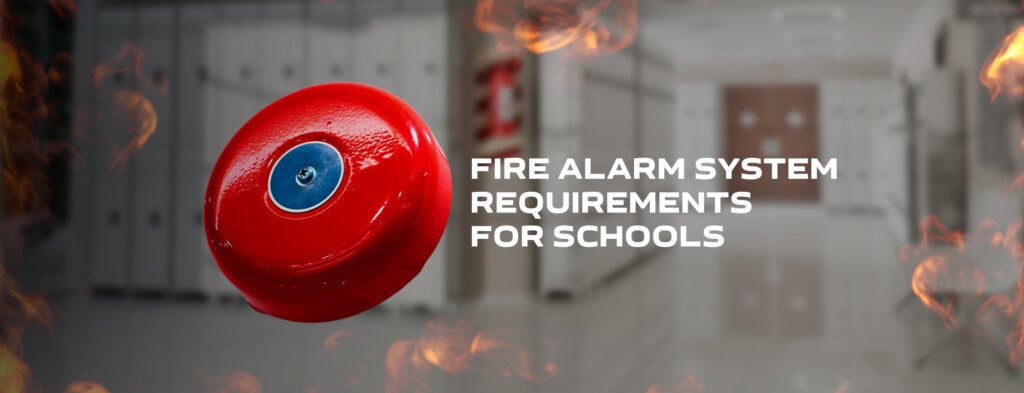
As children attend school, the faculty and staff hold responsibility for safeguarding their well-being and preparing for contingencies such as fires. Likewise, stakeholders such as authorities, inspectors and school districts share the duty of implementing fire safety measures suited to each school’s unique circumstances. Knowing the primary rules and standards behind school fire safety is a must to ensure the well-being of the school’s occupants.

Preparing for a disaster is not only the best practice, but mandated by law. In schools, you are required to have a fire alarm system (see the minimum requirements for a fire alarm system). Hence, you should also have a risk analysis performed by an expert to determine fire alarm requirements, where fire extinguishers must be placed, or if there are any other special considerations. Accordingly, the relevant standards to consider when selecting a fire alarm system for a school can be found in the NFPA 101, otherwise known as life safety code; the NFPA 72, national fire alarm code; and model building codes, like the International Building Code (IBC) and the International Fire Code (IFC).
The NFPA 101 defines educational occupancies as spaces used for educational purposes up to the twelfth grade by six or more persons, with activities lasting 4 hours or more per day or over 12 hours weekly. Additionally, these occupancies encompass preschools, kindergartens, and similar institutions meeting two conditions: educational focus and children aged 24 months or older.
For small facilities or portable buildings, you are not required to have a fire alarm system. This applies if the small facility meets the following criteria: single room or classroom, < 1000 sq. ft., and > 30 ft. away from another building.
These are the major requirements for schools outlined by the NPFA 101:

Beam detectors provide a cost effective method of covering large areas over point smoke detectors. However, attention should be given to ensure that the beam remains unobstructed by activities within the space and that the building’s structure maintains the beam’s placement. Moreover, these types of detectors may result in earlier smoke detection; beam detectors are able to derive their smoke measurement over an area rather than a single location, where smoke will be more distributed as it fills large volumes.
Schools are required to have an emergency action plan to ensure building inhabitants remain safe from harm. As a general rule of thumb, rooms occupied by lower grade students should be closer to ground level floors to assist with their evacuation. Regular fire drills, inspections, and system upgrades & maintenance are imperative to minimize fire risks for children. This is especially the case in schools, where the environment, classrooms, and layout may change or modernize over time. Manual call points should be placed along exit routes, allowing occupants to signal that a fire has been observed as they leave the building.
Here are the primary requirements for fire escape, listed in the NFPA 101:
Sometimes, a school will have special fire hazards present, such as a chemistry lab, kitchen, or wood shop. As such, these rooms may require additional monitoring, or an initiating fire suppression system. Some chemistry labs may require specialized suppression systems designed to address specific chemical hazards. For instance, suppression systems using inert gases like carbon dioxide or argon can be used to displace oxygen and suppress fires without causing damage to sensitive laboratory equipment or chemicals. Finally, rooms with dangerous hazards are required to be separated from the rest of the building by fire barriers having a 1-hour fire resistance rating at minimum.
Vandalism presents a significant challenge in managing fire safety systems, particularly in high schools. Consequently, the installation of vandalism-resistant covers and tamper-proof devices has become more prevalent to reduce maintenance expenses and safeguard delicate equipment. Additionally, student behavior like smoking in restrooms and pranks, contributes to false alarms in school settings. To address the issue of frequent false alarms, the IBC and IFC have modified regulations regarding manual fire alarm boxes, eliminating the requirement in fully sprinklered buildings and reducing the number required in non-sprinklered buildings under specific conditions, including enhanced detection measures.
Fire safety in schools presents difficult challenges due to the presence of adolescents and teenagers. Most fires in schools are caused by occupants, meaning that it is important that fire safety be taught to young children. Also, by implementing updated safety standards, we can ensure optimal protection for our children while considering cost-effectiveness and practicality. We carry a full line of fire sprinklers, smoke detectors, fire extinguishers, and manual pull stations to help you create a more safe environment. Adhering to the standards outlined by fire codes not only ensures legal compliance but also mitigates the risk of fire-related losses.
Monday to Thursday: 8 AM – 7 PM (EST)
Friday: 8 AM – 5 PM (EST)
(888) 497-0290
Quotes: [email protected]
Order Inquiries: [email protected]
Service Inquiries: [email protected]
All Other Inquiries: [email protected]